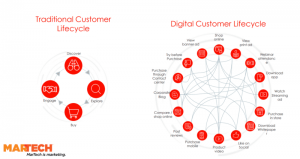— June 22, 2017

qimono / Pixabay
“If you want something new, you have to stop doing something old.”
Today’s CMO is charged with being a transformational leader- whether they’re ready or not. From stewarding the firm through a total digital transformation to evolving marketing from a cost center to a revenue center, CMOs are now the ultimate change agents. Yet most marketing leaders are totally unprepared for this new responsibility and are falling short of expectations.
For example, close to 80% of CMOs report experiencing intense pressure to demonstrate ROI with credible revenue results, yet less than a third report on these types of metrics. This is in spite of the fact we are drowning in technology and tools that fully enable marketing as a revenue center. So, where’s the disconnect between expectations and reality? One word: leadership.
CMO leadership is something I think about… a lot. As I work with senior marketing executives, I see a significant lack of transformational leadership. Part of the deficit arises from the background of the CMO and how we used to run business. For many years, the CMO was valued for their ability to drive the traditional marketing measures such as company positioning, messaging, creative, and communications.
In addition, many CMOs are hired as a ‘special project’ and aren’t empowered to step in as a transformational leader. In our digital world, this is no longer good enough. As marketing leaders strive to respond to the dizzying array of changes, leading with a transformational style becomes a job requirement. Employing transformational leadership acknowledges the sweeping changes required and provides a framework for leading change.
Defining transformational leadership
The essence of a transformational leadership is the ability to motivate others to higher than expected levels of performance and to make extraordinary things happen. Often called ‘quiet leaders’, the transformational leader (TL) leads by example and demonstrates courage, confidence, and willingness to make sacrifices for needed change. These are big words, so let us break it down and apply to the CMO.
Laser-focused vision and communication
The first attribute of a TL includes a tenacious and laser-focused vision for the future – well before others. TLs see a need to change the current system and use a finely tuned and compelling vision as a starting point. They seek to change existing thoughts, techniques, and goals for better results, for better business and for the greater good. As a strong communicator, the TL acts like a good politician with a well-crafted stump speech that they deliver relentlessly.
I’ve seen strong marketing leaders with vision for the future of marketing in a digital world and marketing as a revenue center. Where they begin to fail is in the lack of quality communication. I recently spoke with a group of CEOs about what they really thought about marketing and where they see a gap in their knowledge of revenue marketing. The feedback was simple and unanimous – the CMO has to take a significant amount of time to fully educate and gain buy-in to the vision. These CEOs were very open to new ideas to improve the business and felt like marketing needed to step up in this regard.
Having a meeting or two is just not enough. The CMO as a TL needs a stump speech and a platform for change. Once created, it must be delivered to all constituents as many times as possible, across as many channels as possible, and attuned to the unique needs of each stakeholder.
Mobilize and motivate
TLs are team-oriented masters of mobilizing teams for optimal results. TLs realize that change happens through people and work tirelessly as a coach to provide inspiration, motivation, empathy, and training to attain the desired result. They also push to instill responsibility and accountability at the team level. Because of their constant interactions with the team, TLs are excellent at conflict resolution and balancing short-term goals with long-term vision. Finally, as a builder of rapport and a provider of inspiration, the TL garners respect from all corners of the organization.
In this area, the breakdown in leadership that I see at CMO level is around two things – mobilizing resources and team interaction. If a CMO has a transformational agenda, they must have resources to mobilize and know how to mobilize them. While this is obvious, it doesn’t always happen in reality. Sometimes the CMO doesn’t know how to restructure teams to drive change, and sometimes they simply don’t have enough resources to do the job. In both cases, the CMO needs to figure this out and effectively communicate what they needs to get the job done.
The second breaking point in transformation is the amount of CMO interaction with the team. Given the working definition of a transformational leader, assigning someone else the responsibility and checking in every once in a while does not work. I see this dynamic too often and it’s a recipe for failure. If the transformational leader is missing, transformation will not take place.
Transformation is hard, yet it’s the new responsibility for the CMO, as understanding the characteristics of a transformational leader provides a blueprint for change. So ask yourself, what kind of leader are you and what kind of leader do you need to be? Leaders aren’t just born, even though there are some innate characteristics of leadership. Leaders are and can be made. Given the exciting opportunity in front of today’s CMO, it’s time to embrace change and step up to transformational leadership.
Business & Finance Articles on Business 2 Community
(58)
Report Post







